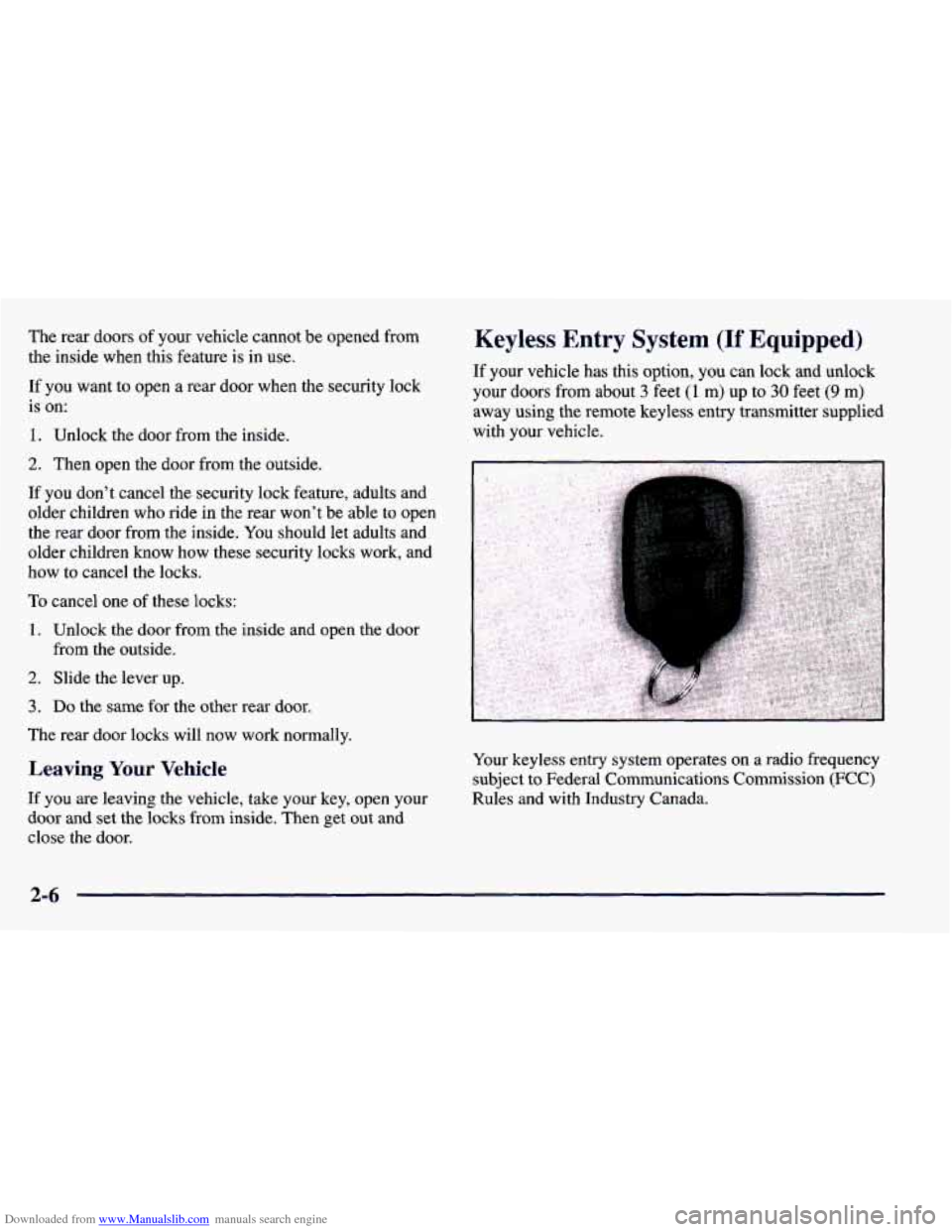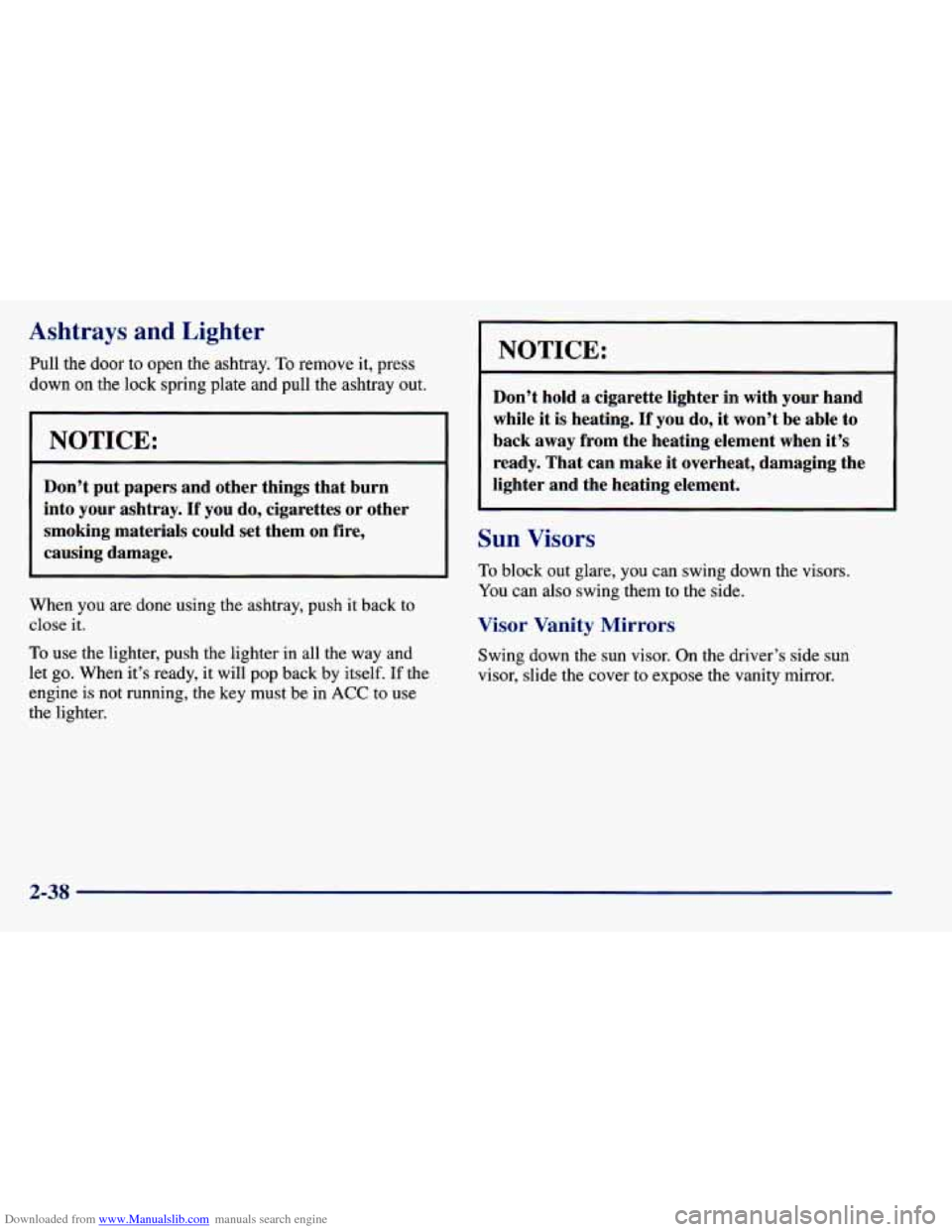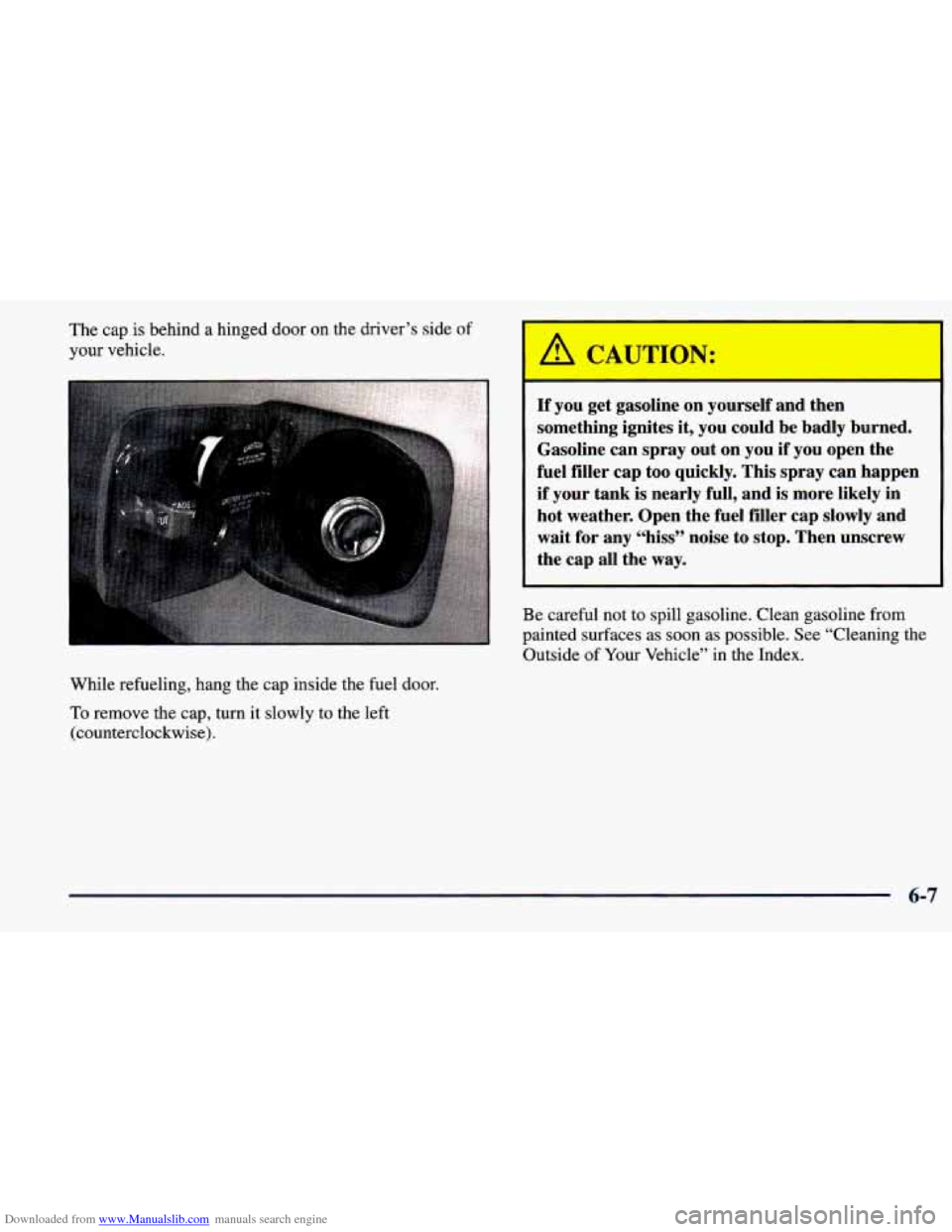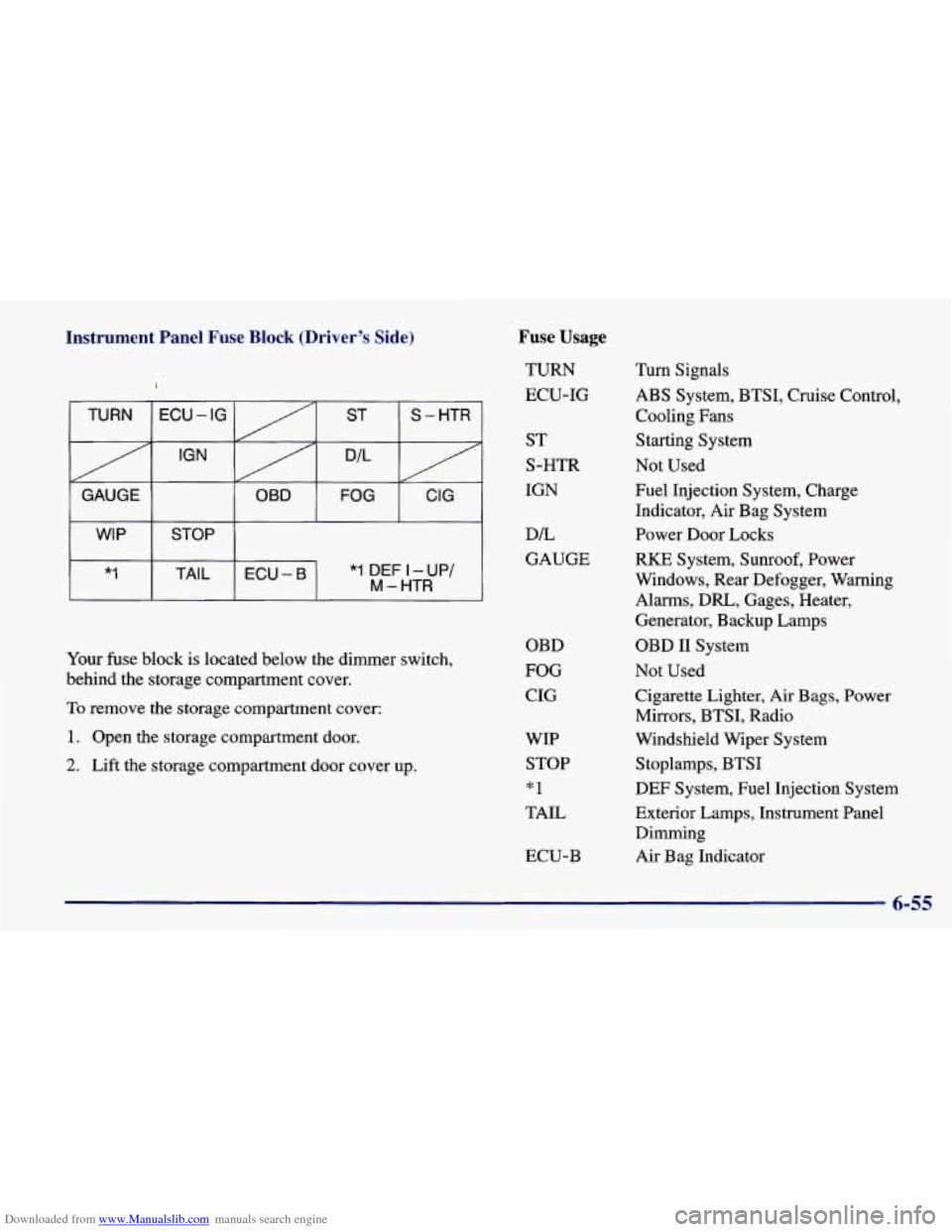1998 CHEVROLET PRIZM door lock
[x] Cancel search: door lockPage 84 of 364

Downloaded from www.Manualslib.com manuals search engine The rear doors of your vehicle cannot be opened from
the inside when this feature
is in use.
If you want to open a rear door when the security lock
is on:
1. Unlock the door from the inside.
2. Then open the door from the outside.
If you don’t cancel the security lock feature, adults and
older children who ride in the rear won’t be able to open
the rear door from the inside. You should let adults and
older children know how these security locks work, and
how to cancel the locks.
To cancel one of these locks:
1. Unlock the door from the inside and open the door
from the outside.
2. Slide the lever up.
3. Do the same for the other rear door.
The rear door locks will now work normally.
Leaving Your Vehicle
If you are leaving the vehicle, take your key, open your
door and set the locks from inside. Then get out and
close the door.
Keyless Entry System (If Equipped)
If your vehicle has this option, you can lock and unlock
your doors from about
3 feet (1 m) up to 30 feet (9 m)
away using the remote keyless entry transmitter supplied
with your vehicle.
Your keyless entry system operates on a radio frequency
subject
to Federal Communications Commission (FCC)
Rules and with Industry Canada.
2-6
Page 85 of 364

Downloaded from www.Manualslib.com manuals search engine This device complies with Part 15 of the FCC Rules.
Operation is subject
to the following two conditions:
(1)
this device may not cause harmful interference, and
(2) this device must accept any interference received,
including interference that may cause undesired operation.
This device complies with RSS-210
of Industry Canada.
Operation is subject to the following two conditions:
(1) this device may not cause interference, and (2) this
device must accept any interference received, including
interference that may cause undesired operation
of
the device.
Changes or modifications to this system by other than
an authorized service facility could void authorization
to use this equipment.
This system has
a range of about 3 feet (1 m) up to
30 feet (9 m). At times you may notice a decrease in
range. This is normal for any remote keyless entry
system. If the transmitter does not work or if you have
to stand closer to your vehicle for the transmitter to
work, try this:
0 Check to determine if battery replacement is
necessary. See the instructions that follow.
Check the distance. You may be too far from your
vehicle.
You may need to stand closer during rainy
or snowy weather.
0 Check the location. Other vehicles or objects may
be blocking the signal. Take
a few steps to the left
or right, hold
the transmitter higher, and try again.
0 If you’re still having trouble, see your dealer or a
qualified technician for service.
Operation
The following functions are available with the remote
keyless entry system:
LOCK: All doors will automatically lock when the
LOCK button on the transmitter is pressed. The
taillamps will flash once, to confirm that the doors
have locked. The interior lamps will stay on for two
seconds after all of the doors are closed. The remote
lock function will not work
if the key is in the ignition.
UNLOCK: The driver’s door will unlock automatically
when the UNLOCK button
on the transmitter is pressed.
The taillamps will flash twice and the interior
lamps will
come on to confirm that the doors have unlocked.
If the
unlock button is pressed again within five seconds, all
remaining doors will unlock. The interior lamps will
stay on for 15 seconds or until the ignition is turned on.
If unlock is pressed and no door is opened, the doors
will lock automatically after
30 seconds.
Page 88 of 364

Downloaded from www.Manualslib.com manuals search engine Trunk Lock Release Theft
To open the trunk lid, use your key and turn it to
the right.
To close the lid, lower and press down on it. After
closing the lid, try pulling it up to make sure it is closed.
Remote Trunk Lock Release
nw Pull the lever on the floor
near the driver’s door to
open the trunk lid from
inside your vehicle. Vehicle
theft
is big business, especially in some cities.
Although your vehicle has a number
of theft-deterrent
features, we know that nothing we put
on it can make
it impossible to steal. However, there are ways you
can help.
Key in the Ignition
If you leave your vehicle with the keys inside, it’s an
easy target for joy riders or professional thieves
-- so
don’t do it.
When
you park your vehicle and open the driver’s door,
you’ll hear a tone reminding you to remove your key
from the ignition and take
it with you. Always do this.
Your steering wheel will be locked, and
so will your
ignition. If you have an automatic transaxle, taking your
key out also locks your transaxle. And remember to
lock the doors.
Parking at Night
Park in a lighted spot, close all windows and lock your
vehicle. Remember to keep your valuables out
of sight.
Put them in a storage area, or take them with you.
2-10
Page 90 of 364

Downloaded from www.Manualslib.com manuals search engine ACC (ACCESSORY) (B): In this position, you can
operate some of your electrical power accessories (such
as the radio, but not the ventilation fan). It unlocks the
steering wheel and ignition.
To move the key from ACC
to LOCK, push in the key and then turn it to LOCK.
ON (C): The switch returns to this position after you
start your engine and release the switch. The switch
stays in the
ON position when the engine is running. But
even when the ignition is not running, you can use ON
to operate your electrical power accessories (including
the ventilation fan) and to display some warning and
indicator lights.
START (D): This position starts the engine. When the
engine starts, release the key. The ignition switch will
return to ON for normal driving.
When the engine is not running,
ACC and ON allow
you to operate some
of your electrical accessories.
A warning tone will sound if you open the driver’s
door when the ignition
is in ACC or LOCK and the
key is in the ignition. On manual transaxle
vehicles, turning the key to
LOCK and removing it will lock the steering
column and result in
a loss of ability to steer the
vehicle. This could cause
a collision. If you need
to turn the engine off while the vehicle is moving,
turn the key only to
ACC. Don’t push the key in
while the vehicle is moving.
NOTICE:
If your key seems stuck in LOCK and you can’t
turn it, be sure you are using the correct key; if
so, is it all the way in? If it is, then turn the
steering wheel left and right while you turn the
key hard. But turn the key only with your hand.
Using
a tool to force it could break the key or the
ignition switch. If none
of this works, then your
vehicle needs service.
2-12
Page 111 of 364

Downloaded from www.Manualslib.com manuals search engine Lamps On Reminder
If you turn the ignition to LOCK or ACC and leave the lamps
on, you’ll hear a tone when you open the driver’s door.
Daytime Running Lamps
Daytime Running Lamps (DRL) can make it easier for
others to
see the front of your vehicle during the day.
DRL can be helpful in many different driving
conditions, but they can be especially helpful in
the
short periods after dawn and before sunset.
The DRL system will make your low-beam headlamps
come on at a reduced brightness when the parking brake
is released with the engine started, even with the lamp
switch in the
OFF position. They will not go off until
the engine is turned off.
When you
turn on the headlamp switch, your DRL will go
out and your headlamps will come on. The other lamps
that come on with your headlamps will also come on.
When you turn
off the headlamp switch, the regular
lamps will go off and your low-beam headlamps come
on at the reduced brightness of DRL. DRL also comes
on if you are only using the parking lamps.
As with any vehicle, you should turn on the regular
headlamp system when you need
it.
Automatic Light Control
Your vehicle is equipped with an automatic light sensor
on top of the instrument panel, so be sure it is not
covered which will cause the nighttime lights to be
on continuously.
When
it is dark enough outside, your ALC will turn
on your low-beam headlamps at the normal brightness
along with other lamps such as the taillamps,
sidemarker, park lamps and instrument panel lights.
There is
a 20-second delay in the transition between
daytime and nighttime operation of the DRL and the
ALC systems. If the light sensor senses a reduction
in lighting that lasts longer than
20 seconds, it will
activate the nighttime lamps. If you are driving through
a parking garage, heavy overcast weather, a tunnel or
fueling your vehicle in a low light area, the ALC will
turn on your low-beam headlamps at a normal
brightness along with the taillamps, sidemarker, park
lamps and the instrument panel lights. The radio lights
will be dimmer.
As with any vehicle, you should turn on the regular
headlamp system when you need it.
2-33
Page 116 of 364

Downloaded from www.Manualslib.com manuals search engine Ashtrays and Lighter
Pull the door to open the ashtray. To remove it, press
down
on the lock spring plate and pull the ashtray out.
NOTICE:
Don’t put papers and other things that burn
into your ashtray.
If you do, cigarettes or other
smoking materials could set them
on fire,
causing damage.
When you are done using the ashtray, push it back to
close
it.
To use the lighter, push the lighter in all the way and
let
go. When it’s ready, it will pop back by itself. If the
engine
is not running, the key must be in ACC to use
the lighter.
NOTICE:
Don’t hold a cigarette lighter in with your hand
while it is heating.
If you do, it won’t be able to
back away from the heating element when it’s
ready. That can make it overheat, damaging the
lighter and the heating element.
Sun Visors
To block out glare, you can swing down the visors.
You can also swing them to the side.
Visor Vanity Mirrors
Swing down the sun visor. On the driver’s side sun
visor, slide the cover to expose the vanity mirror.
2-38
Page 233 of 364

Downloaded from www.Manualslib.com manuals search engine The cap is behind a hinged door on the driver’s side of
your vehicle.
While refueling, hang the cap inside the fuel door.
To remove the cap, turn it slowly to the left
(counterclockwise).
A ,CAUTION
If you get gasoline on yourself and then
something ignites it, you could be badly burned.
Gasoline can spray out on you if you open the
fuel filler cap too quickly. This spray can happen
if your tank is nearly full, and is more likely in
hot weather. Open the fuel filler cap slowly and
wait for any “hiss” noise to stop. Then unscrew
the cap all the way.
Be careful not to spill gasoline. Clean gasoline from
painted surfaces as soon as possible.
See “Cleaning the
Outside of Your Vehicle” in the Index.
6-7
Page 281 of 364

Downloaded from www.Manualslib.com manuals search engine Instrument Panel Fuse Block (Driver's Side)
1
TURN S - HTR ST ECU - IG
IGN D/L
GAUGE CIG FOG OBD
WIP STOP
*I DEF I - UP/
M - HTR
Your fuse block is located below the dimmer switch,
behind the storage compartment cover.
To remove the storage compartment cover:
1. Open the storage compartment door.
2. Lift the storage compartment door cover up.
Fuse Usage
TURN
ECU-IG
ST
S-HTR
IGN
DL
GAUGE
OBD
FOG
CIG
WIP STOP
"1
TAIL
ECU-B
Turn Signals
ABS System, BTSI, Cruise Control,
Cooling Fans
Starting System
Not Used
Fuel Injection System, Charge
Indicator, Air Bag System Power Door
Locks
RKE System, Sunroof, Power
Windows, Rear Defogger, Warning Alarms,
DRL, Gages, Heater,
Generator, Backup Lamps
OBD 11 System
Not Used
Cigarette Lighter, Air Bags, Power
Mirrors, BTSI, Radio
Windshield Wiper System
Stoplamps, BTSI
DEF System, Fuel Injection System
Exterior Lamps, Insmment Panel
Dimming
Air Bag Indicator
6-55